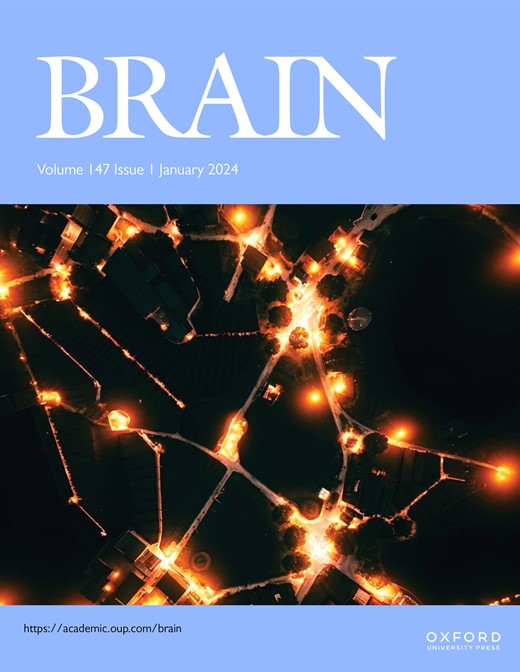沿阿尔茨海默病连续体的唐氏综合症内侧颞叶萎缩
IF 10.6
1区 医学
Q1 CLINICAL NEUROLOGY
引用次数: 0
摘要
内侧颞叶结构是最先受到神经原纤维缠结病理影响的区域之一,这些区域的体积变化有望成为阿尔茨海默病的生物标志物。迄今为止,对唐氏综合症患者这些区域的完整性知之甚少,这一人群几乎总是会患上阿尔茨海默病,因此提供了一个独特的机会来确定与该疾病相关的最早的结构变化。我们的目的是描述内侧颞叶结构与阿尔茨海默病进展的顺序参与,探索与阿尔茨海默病病理的液体生物标志物的关联,并评估区域体积和皮层厚度在区分唐氏综合征阿尔茨海默病临床分期中的作用。138名整倍体对照和259名唐氏综合征成人患者接受了临床评估和MRI扫描,随后在t1加权图像上对内侧颞叶进行了自动分割。参数统计检验和局部回归模型用于评估区域体积/皮质厚度与阿尔茨海默病临床分期、估计发病年数和脑脊液生物标志物之间的横断面关联。此外,使用接受者操作特征曲线下的面积来评估标记物区分临床分期的能力。结果显示,随着阿尔茨海默病的进展,内侧颞叶的体积和皮质厚度逐渐减少,所有亚区在痴呆期都显示体积/厚度减少。无症状组和前驱症状组海马前后区有显著差异。我们发现,在唐氏综合症中,内嗅皮层和海马体后部是最早丧失的区域,在阿尔茨海默病症状出现之前的13-15年就开始了。我们观察到随着疾病进展的非线性结构变化,某些结构(例如,海马旁皮质)的特征是最初皮质厚度增加,随后变薄。在所有亚区中,海马体积与CSF a - β42/40、pTau181和神经丝轻链水平的相关性最密切。进一步的分析表明,与脑脊液生物标志物类似,海马体在区分唐氏综合征患者无症状与前驱/痴呆性阿尔茨海默病个体方面具有很高的预测价值。该研究为唐氏综合征患者颞叶内侧结构的进行性、非线性体积变化与阿尔茨海默病病理的关系提供了新的认识,这对使用MRI监测神经变性的临床试验具有重要意义。我们还表明,MRI信息可以完善唐氏综合征临床状态的预测。这在唐氏综合症中尤其重要,由于神经发育性智力残疾,早期临床阶段可能很难发现。本文章由计算机程序翻译,如有差异,请以英文原文为准。
Medial temporal lobe atrophy in Down syndrome along the Alzheimer's disease continuum
Medial temporal lobe structures are among the first areas impacted by neurofibrillary tangle pathology, making volumetric changes of these areas promising biomarkers for Alzheimer's disease. To date, little is known about the integrity of these regions in individuals with Down syndrome, a population which almost invariably develops Alzheimer's disease and thus offers a unique opportunity to determine the earliest structural changes related to the disease. We aimed to characterize the sequential involvement of medial temporal lobe structures with Alzheimer's disease progression, explore associations with fluid biomarkers of Alzheimer’s pathology, and assess the utility of regional volumes and cortical thickness in distinguishing Alzheimer’s disease clinical stages in Down syndrome. 138 euploid controls and 259 adults with Down syndrome underwent clinical assessment and MRI scanning, followed by automated segmentation of the medial temporal lobe on T1-weighted images. Parametric statistical tests and local regression models were used to assess the cross-sectional association between regional volumes/cortical thickness and Alzheimer’s disease clinical stage, estimated years of onset, and CSF biomarkers. Additionally, markers were assessed in their ability to distinguish clinical stages using area under the receiver-operating characteristic curves. Results showed a progressive loss of volume and cortical thickness in medial temporal lobe with advancing Alzheimer’s disease stage, showing reduced volume/thickness at the dementia stage in all subregions. The asymptomatic and prodromal groups showed significant differences in the anterior and posterior hippocampus. We identified the entorhinal cortex and posterior hippocampus as the regions showing the earliest loss in Down syndrome, starting 13-15 years before Alzheimer’s disease symptom onset. We observed non-linear structural changes with disease progression, with certain structures (e.g., the parahippocampal cortex) characterized by an initial increase in cortical thickness followed by subsequent thinning. Of all subregions, the hippocampal volumes showed the closest correlation to CSF Aβ42/40, pTau181, and neurofilament light chain levels. Further analyses demonstrated a high predictive value, similar to CSF biomarkers, of the hippocampus in differentiating between individuals with asymptomatic versus prodromal/demented Alzheimer’s disease in Down syndrome. This study provides a novel understanding of the progressive, non-linear volumetric changes of medial temporal lobe structures in relation to Alzheimer’s disease pathology in Down syndrome, which can have important implications for clinical trials monitoring neurodegeneration using MRI. We also show that MRI information can refine the prediction of clinical status in Down syndrome. This is particularly relevant in Down syndrome, where early clinical stages can be challenging to detect due to neurodevelopmental intellectual disability.
求助全文
通过发布文献求助,成功后即可免费获取论文全文。
去求助
来源期刊

Brain
医学-临床神经学
CiteScore
20.30
自引率
4.10%
发文量
458
审稿时长
3-6 weeks
期刊介绍:
Brain, a journal focused on clinical neurology and translational neuroscience, has been publishing landmark papers since 1878. The journal aims to expand its scope by including studies that shed light on disease mechanisms and conducting innovative clinical trials for brain disorders. With a wide range of topics covered, the Editorial Board represents the international readership and diverse coverage of the journal. Accepted articles are promptly posted online, typically within a few weeks of acceptance. As of 2022, Brain holds an impressive impact factor of 14.5, according to the Journal Citation Reports.
 求助内容:
求助内容: 应助结果提醒方式:
应助结果提醒方式:


